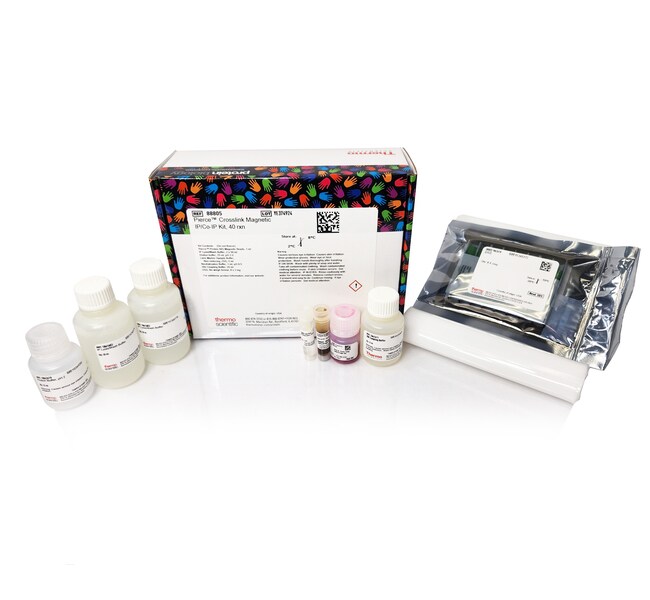
The Thermo Scientific Pierce Crosslink Magnetic IP/Co-IP Kit uses crosslinking chemistry to covalently immobilize IP antibodies onto premium-quality Protein A/G Magnetic Beads for effective immunoprecipitation and co-immunoprecipitation.
Because this magnetic IP procedure involves covalent attachment of the specific antibody used for immunoprecipitation, target proteins or co-IP protein complexes can be eluted and analyzed without antibody fragments because the antibody remains affixed to the beads. The kit contains an optimized protocol and all buffers and reagents necessary to accomplish high-yield IP or co-IP with antibodies that bind to Protein A/G and using either manual or automated magnetic separation tools.
Features of the Crosslink Magnetic IP/Co-IP Kit:
• Antibody-free IP—antibody is irreversibly attached to the magnetic beads resulting in negligible co-elution of intact antibody or heavy and light chains with the purified antigen
• Convenient—the IP/co-IP kit contains magnetic beads and all essential buffers for optimal immunoprecipitation
• Fast—complete crosslinking and immunoprecipitation in less than 3 hours
• Efficient—immunoprecipitate with half the recommended volume of magnetic particles compared to other magnetic beads
• Compatible—magnetic beads coupled with Protein A/G recombinant protein ensures compatibility with most primary antibodies, whether from mouse or rabbit
• Scalable—use only the amount of antibody needed for a single IP experiment or prepare a larger quantity of antibody-crosslinked magnetic beads for multiple experiments
The protocol for the Pierce Crosslink Magnetic IP/Co-IP Kit binds IP antibody to Protein A/G Magnetic Beads and then covalently crosslinks the antibody to the beads using disuccinmidyl suberate (DSS). The antibody-crosslinked beads are then incubated with cell lysate or tissue extract that contains the protein antigen of interest, allowing the antigen:antibody complex to form. The beads are washed to remove non-bound material and a low pH elution buffer is used to dissociate bound antigen from the antibody-crosslinked beads. Neutralization buffer is included to prevent precipitation of the isolated antigen and to ensure protein activity in downstream applications. Lane Marker Sample Buffer is included for preparing samples for SDS-PAGE analysis. The protocol is optimized for 2 to 10µg of IP antibody. For optimal co-IP yields, use 5 to 10µg of antibody. The beads are removed from the solution manually using a magnetic stand or by automation with an instrument such as the Thermo Scientific KingFisher Flex Instrument.
Traditional IP (without covalent antibody attachment) generally provides higher antigen yields than IP protocols that used crosslinking. This is because the crosslinking process inevitably causes loss of some functional antibody binding sites. To overcome this limitation with the crosslink method, it may be necessary to use somewhat greater amounts of IP antibody in the crosslink IP method than in the equivalent traditional IP procedure. Of course, the advantage with the crosslink immunoprecipitation procedure is Western blots devoid of interfering antibody bands.
Protocol Summary
1: Prewash beads with 1X Coupling Buffer.
2: Bind antibody to Protein A/G magnetic beads for 15 minutes.
3: Wash beads three times with 1X Coupling Buffer.
4: Crosslink antibody to beads with DSS for 30 minutes.
5: Wash bead three times with Elution Buffer and then twice with IP Lysis/Wash Buffer.
6: Incubate cell lysate with prepared beads for 1-2 hours at room temperature or overnight at 4°C.
7: Wash beads twice with IP Lysis/Wash Buffer and then once with purified water.
8: Elute bound antigen.
Related Products
Pierce™ Crosslink IP Kit
| Code | Description |
|---|---|
| 88805 | Catalog Number: 88805 |

